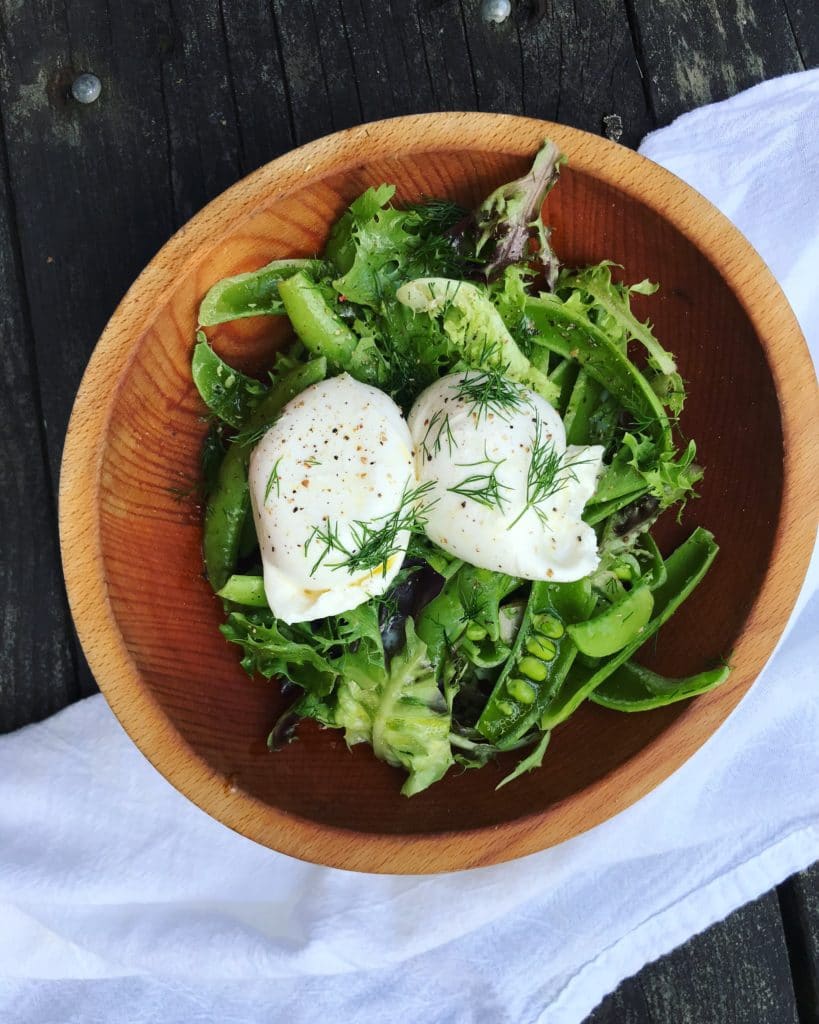Week #8, Other farmer friends made the same decision.
- On: July 08, 2020
 2
2
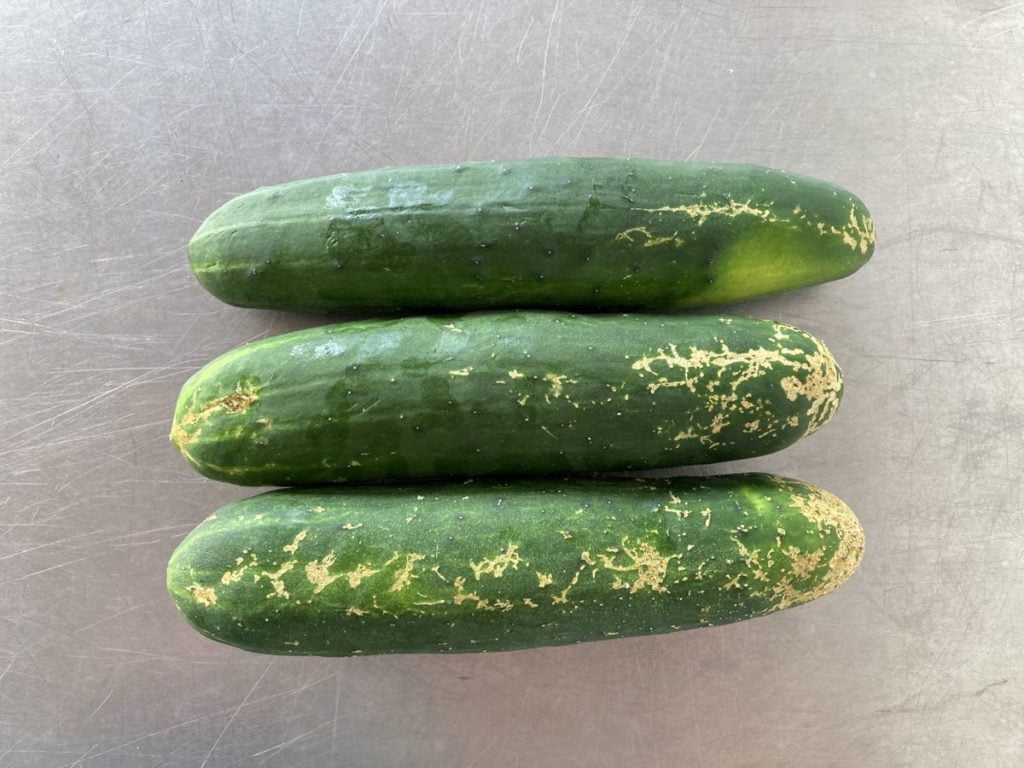
Almost every cucumber has some level of insect feeding damage. Consider peeling your cukes, at least the sides with scarring.
A grower on our farmer listserv wrote that he missed the window to protect his zucchini seedlings with row cover, and that the cucumber beetles became unrelenting. That happened for us too, as well as other local farms. Steve replied with this explanation of why we didn’t get our usual row cover protection in place. Row cover is lightweight fabric that we use to cover fields in spring to capture warmth and exclude insects.
“We also are seeing very large numbers of cuke beetles this late spring. For many years we have transplanted zucchini, summer squash, cucumbers and melons into green plastic mulch and applied row covers within one to two days. This year we missed that window for covering, and were inundated with beetles. Why didn’t we cover right away? We didn’t have our drip irrigation set up; the main line got torn up last fall and we had yet to rebuild it. The hot sunny weather after transplanting made covering very risky – we’ve lost too many cucurbit plants by covering during hot spells without concurrent drip irrigation. Also, we finished transplanting on a Friday evening– 2 hours after our usual quitting time. By Monday morning, when our crew returned, it was too late.”
Sometimes a tweak of the weather has unplanned consequences. We worked late that Friday night to get the zucchini planted before a rain storm and this was the outcome. It’s interesting to learn that other farmers’ decision-making converged in this way.
We’ve begun harvesting both zucchini and summer squash so clearly the crops survived. Green zucchini harvests are low for now; a few varieties were particularly hard-hit by the beetles. The cucumbers have a lot of insect scarring; they are the beetles’ favorite host. Let’s wait and see if the scarring abates once there are more cucumbers in the field to spread the beetle damage.
Our crops (and weeds!) grow 50% faster in weather this hot.
Can we work 50% faster?
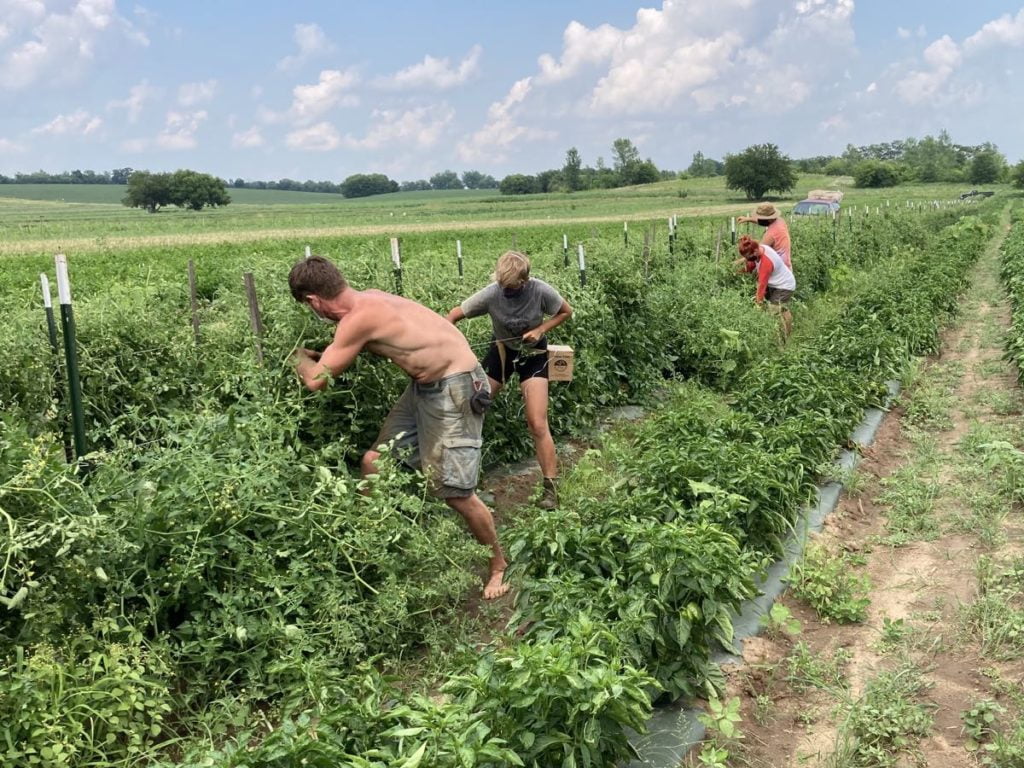
Obviously not. Our work is very difficult in the ridiculous heat. We need lots of water and Gatorade and more breaks in the shade than usual. In the photo, Billy, Demi, Courtney and David trellis tomato plants. The tomato growth rate has been astonishing and the plants got tossed over during recent storms. One person gathers the plants while the other person weaves string around them in a supporting figure-eight pattern, tied to the stakes. With this dastardly job, we can’t even take off our masks because we’re working so close together. Otherwise, masks are off whenever we can work far apart outside.
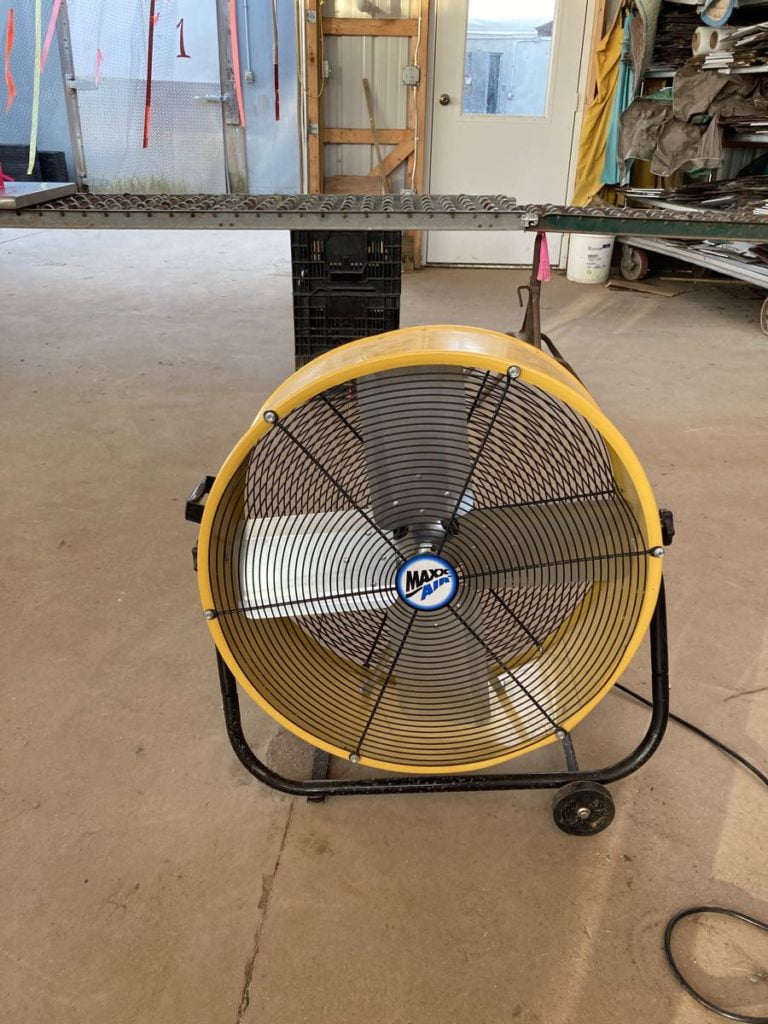
Our heavy barn fans save the day. We bought several to dry garlic in our barn loft. Now we use them for ventilation and to cool our work spaces. They are so, so great.
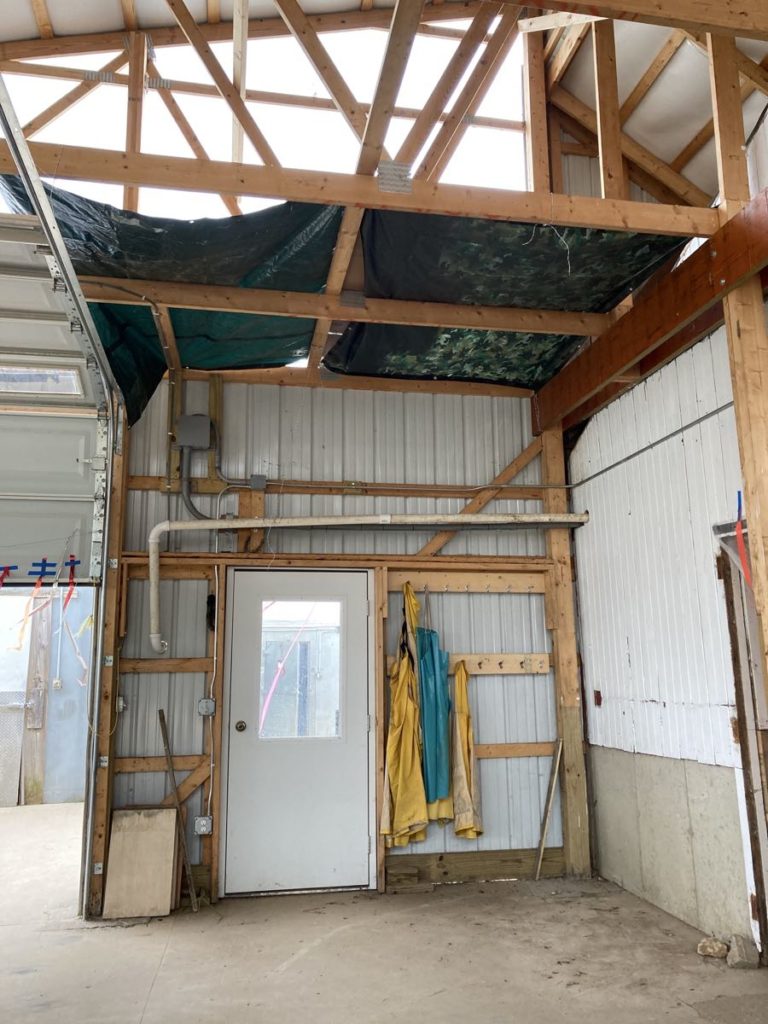
We suspended tarps over a corner of the pack shed. We appreciate the light from our tall peaked roof but the sun is too much for us right now.
Veggie List & Veggie Notes
Week #8, July 9/10, 2020
– Weekly shares
– EOW/ purple
– Sampler/ moon
Sugar snap peas, 2 1/4 lb
Cucumbers, 4
Zucchini or summer squash, 2 to 2.5 lb
Red bibb lettuce
Green bell pepper, 2
Broccoli, a few heads
Basil, 1 – 2 large sprigs
Garlic scapes, 1 small handful
Some sites get 1 sunflower, for beauty.
Next week’s box will probably contain cucumbers, zucchini &/or summer squash, Walla Walla onion, basil and more.
Sugar snap peas – This has been an amazing pea season, despite the heat. Enjoy this huge bag.
Cucumbers – I bet you all know what to do with cucumbers.
Storage: Cucumbers need refrigeration but do best at about 48 F. Store in a warmer part of your fridge – that’s the best compromise.
Green bell pepper – The first of the season!
Basil – Yum, the first tender basil, perfect to combine with garlic scapes, zucchini, snap peas, etc.
Storage: Basil will blacken if stored in the refrigerator. It is best stored at room temperature with the cut ends in water, for example in a jar or vase. Treat it like a flower. Give the stem a fresh trim and change the water every day or two.
Garlic scapes (curly green things) – Use scapes as a substitute for garlic cloves. They can be minced, mixed with olive oil, and added to stir fries or simple pasta dishes. The scapes can be sautéed, but will not brown like garlic cloves. Expect them to retain their crunch even when cooked, and to be milder than garlic cloves, closer in pungency to the green garlic we’ve sent.
Sunflower (for some sites) – We continue experimenting with sunflowers. They are one of the few flowers that we can send in the CSA boxes. This cheerful variety ‘Vincent’s Choice’ does not produce pollen, making it a good choice to pack with vegetables. The sunflowers are for beauty and joy, not to eat!
Storage: Trim the stem and place in water. If you re-trim the stem and change the water a few times, the flower should last about one week.
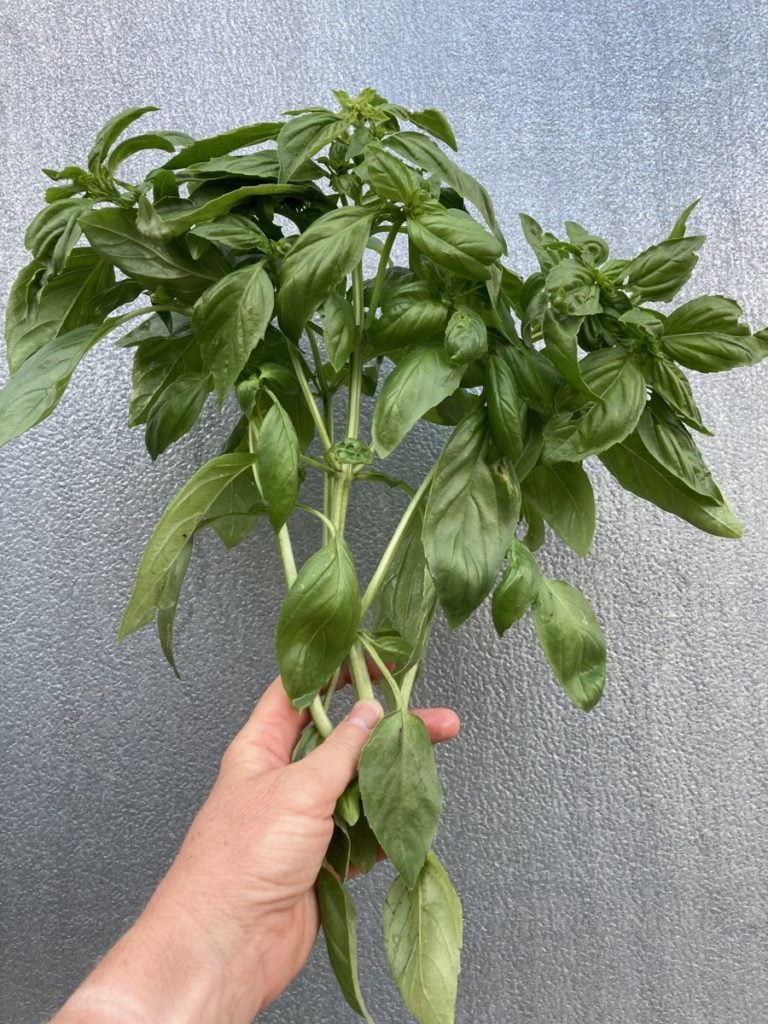
Everyone gets one or two branched sprigs of basil.
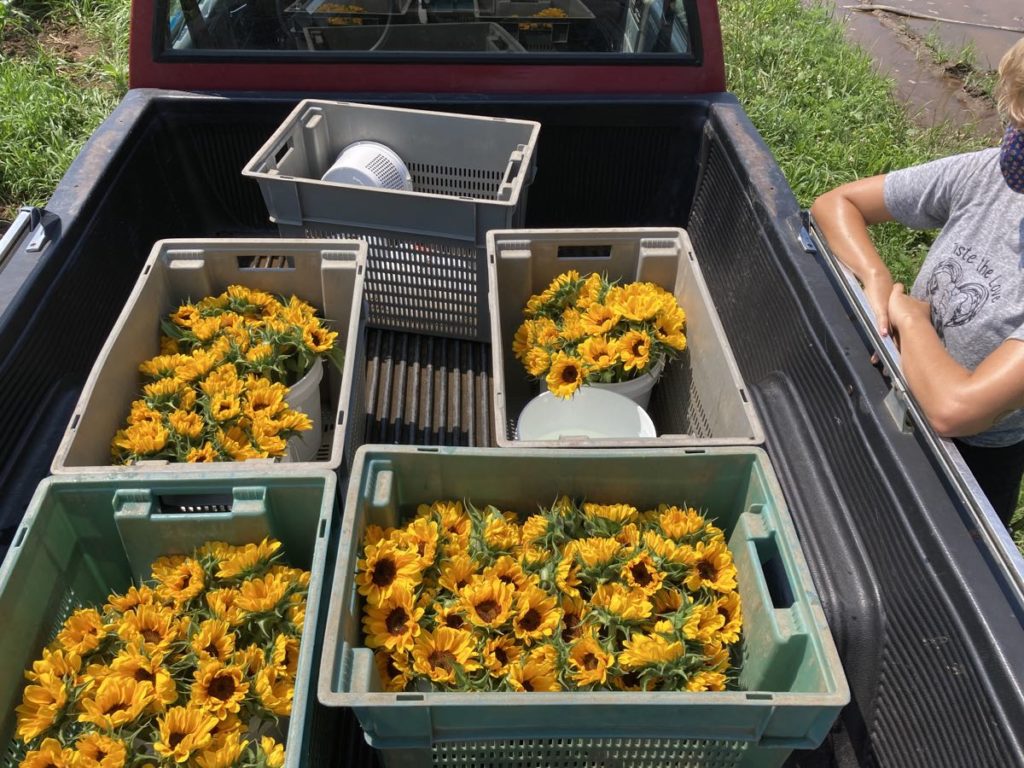
A load of sunflowers, with Demi.
RECIPES
Visit our 2020 Recipe Log or our 2019 Recipe Log or join our Facebook discussion group.
LOCAL THYME/ Cooking 101
Broccoli Pesto
Broccoli, Cucumber and Pepper Salad with Sesame
LOCAL THYME/ Cooking 202
Broccoli Sausage Strata
Thai Pickled Cucumber
Quinoa Salad with Snap Peas, Garlic Scapes, and Zucchini
LOCAL THYME/ Quick & Easy Meal
Broccoli Pesto Flatbreads with Grilled Zucchini
RECIPES FROM LAUREN
Takes 15 minutes
Serves 2-4
1-2 pounds snap peas (as many as you are willing to spare), cut in half lengthwise
1 head lettuce, leaves torn
3 tablespoons olive oil
2 tablespoons lemon juice
Kosher salt
Black pepper
1 (8 ounce) ball or 2 (4 ounce) balls fresh burrata
1. In a large bowl, toss snap peas (cut in half lengthwise) and any peas that fall onto your cutting board with lettuce.
2. Drizzle with olive oil, lemon juice, a good pinch of Kosher salt and several grinds of freshly ground black pepper. Toss to combine. Taste and adjust seasonings as desired.
3. Serve with burrata and a few more grinds of pepper.
.
????
.
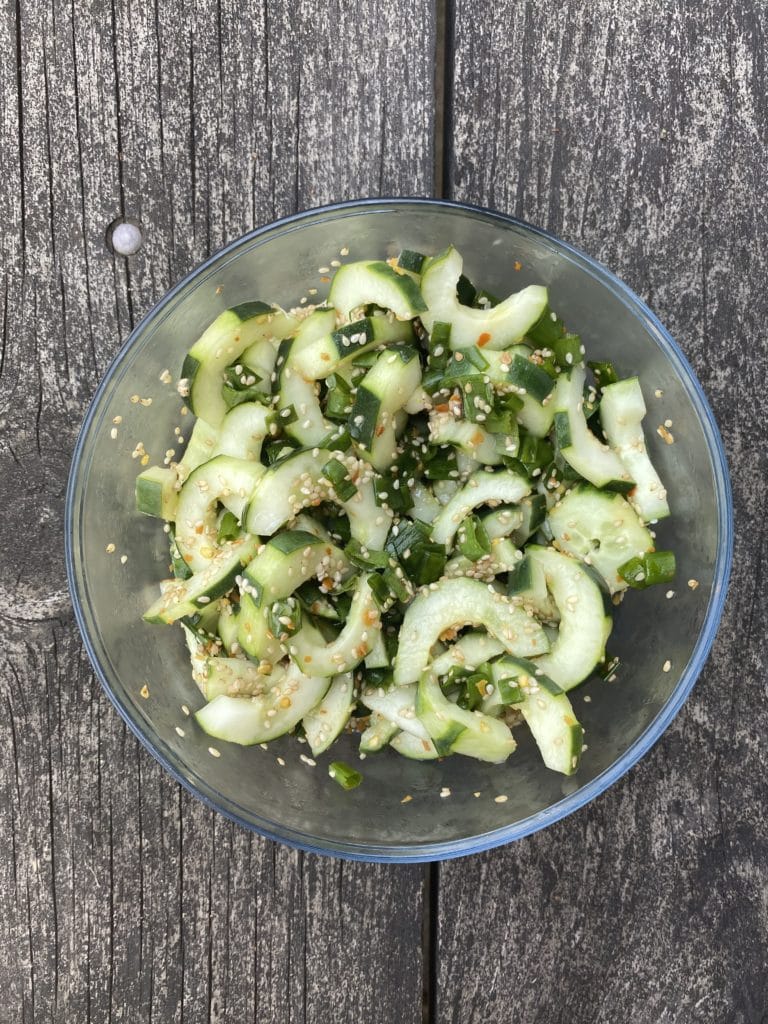
CRUNCHY CUCUMBER SALAD
Takes 10 minutes
Serves 2-4
3 cucumbers, halved lengthwise and seeded
1 tablespoon rice wine vinegar
1 tablespoon olive oil
2 tablespoons sesame seeds
1 teaspoon sugar
1/2 teaspoon red pepper flakes
1/4 teaspoon Kosher salt
1. Combine all ingredients in a medium bowl. Toss to combine. Eat at room temperature or chill before serving. It will get a bit soggier than longer you wait to eat it, but still taste delicious.
.
????
.
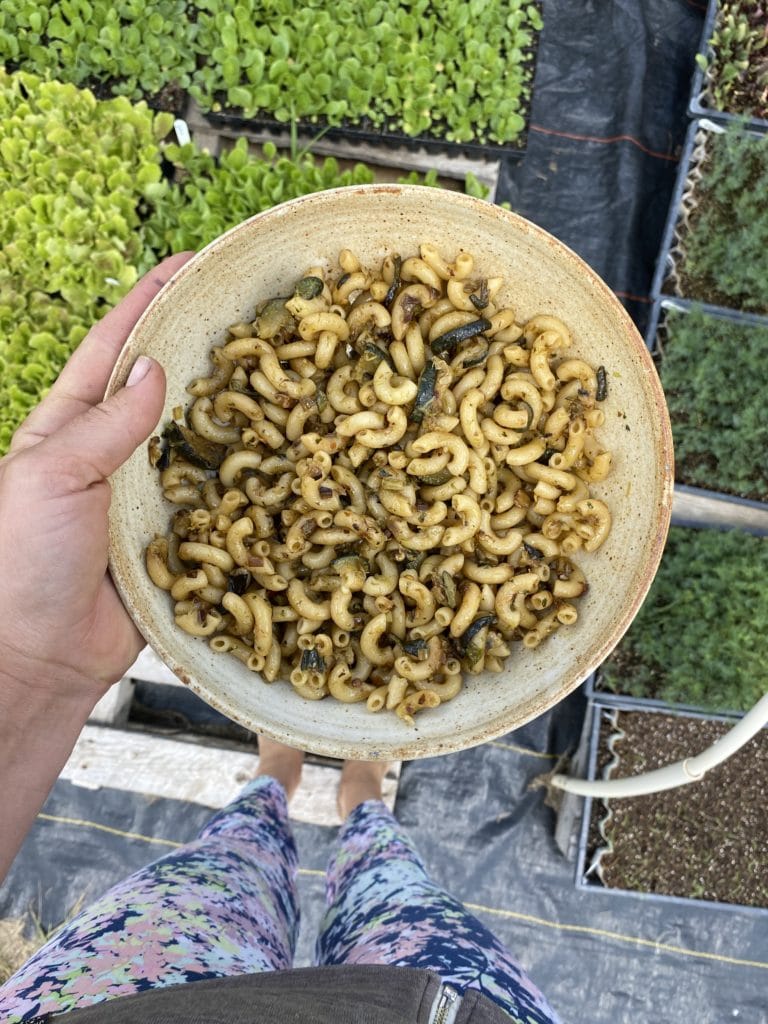
JAMMY ZUCCHINI PASTA
Takes 40 minutes
Serves 4-6
1/4 cup olive oil
1 bunch garlic scapes, thinly sliced
2 green peppers, diced
2 pounds zucchini, quartered lengthwise and sliced
1/2 teaspoon red pepper flakes
12 ounces pasta of your choice (ziti or elbows work great)
2 ounces Parmesan, finely grated
1/4 cup basil leaves
- Heat oil in a large skillet over medium heat. Cook garlic scapes until lightly browned, about 5 minutes. Add peppers and zucchini. Increase heat to medium high and sprinkle mixture with salt (about 1/2 teaspoon). Let it cook until the zucchini begins to break down then turn heat to low. Continue cooking and stirring until squash is jammy and soft, about 15 minutes. It will stick a little bit. Don’t worry about that. Add pepper flakes.
- Meanwhile, bring a large pot of salted water to a boil on the stovetop. Cook pasta according to package direction. When done, drain, reserving 2 cups of pasta water.
- Transfer pasta to zucchini mixture and add half the reserved pasta water. Stir with a wooden spoon to combine and scrape any of the jammy zucchini from the bottom of the pan. Add cheese and stir until sauce coats pasta. Add more pasta water if the mixture is too thick or the cheese is clumping/not mixing well. Remove from heat and add in the basil.
- Enjoy warm!
.

